Moon Rise and Set Extremes

Have you noticed how low the Moon is in the sky? She will reach her lowest path in May on the 15th.
The Moon on our Horizon
As well as observing how high and low the Moon’s path reaches in our sky, we can also notice differences in how far north and south she rises and sets on our horizon.
When the Moon reaches her lowest path in the sky, she rises and sets furthest to the south.
When the Moon reaches her highest path in the sky, she rises and sets furthest to the north.
At the Major Lunar Standstill, the Moon rise and set locations on our horizon are at their most extreme. When at her lowest path, she will rise and set further south than the winter solstice Sun. When at her highest path, she will rise and set further north than the summer solstice Sun.

Moon rise and set – 15th May – lowest path in May
Sun Rise & Set
Over the period of a year, where the Sun rises on the horizon swings from north of east to south of east and back again. Where the Sun sets on the horizon swings from north of west to south of west and back again.
When the Sun reaches its maximum, this is a solstice, which is when the Sun stands still before changing direction.

Moon Rise & Set
The Moon does in one month what the Sun does in one year.

The Moon’s 18.6 Year Cycle
At the Major Lunar Standstill, the Moon’s rise and set on our horizon is the most extreme swinging more north and south than the solstices. Over the next few years, the maximum positions of the Moon each month become noticeably less extreme until they reach the same range as the solstices.
The Moon’s swing continues to decrease further until it reaches its minimum range. This is the Minor Lunar Standstill which occurs halfway through the cycle at 9.3 years. At this point, the Moon’s swing is at its least extreme and so difficult to notice. From the Minor Lunar Standstill, the Moon’s swing begins to increase again until it reaches its maximum again at the Major Lunar Standstill.
About halfway between the Minor and Major Lunar Standstills, the maximum rising points of the Moon match those that the Sun reaches each year at the solstices.

Your Location
Can you notice where the Moon rises and sets from your location on the days we reach the extremes of high and low? If you can’t see it physically because of cloud or if you have something obstructing your view, then we’d recommend using peakfinder.com which shows the rise and set points of the Sun and Moon from any location. It’s fascinating to see how far north and south the Moon is rising and setting in the Major Lunar Standstill season! Every location is relative so you can still map the range even with a big hill in the way as long as you use the same location and viewpoint.
You can also use Stellarium.com which shows the rise and set locations with no obstructions if you set the terrain to Ocean. Ultimately, the best way to track the Moon is with our own eyes. Check your lunar calendar for the highest and lowest Moons then see where she rises on your horizon.
Good luck and do share your observations.
Our Journey to Callanish
Back in 2006, we travelled up to the Callanish stone circle in the Outer Hebrides to witness the lowest Full Moon in the 18.6 year lunar cycle. We’re now really excited to be preparing to make that journey once again – a whole lunar cycle later… We leave next week so we’re now on a count down and very excited to be setting of on our adventure.
Tina & Ceri x


You must be logged in to post a comment. If you do not have an account, register here.